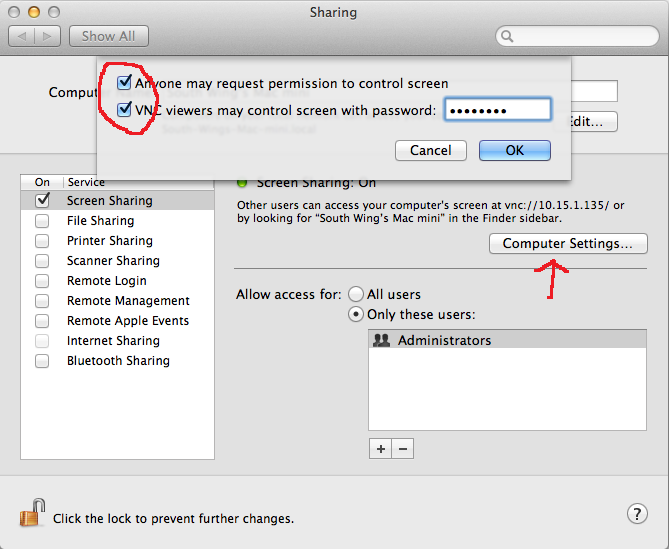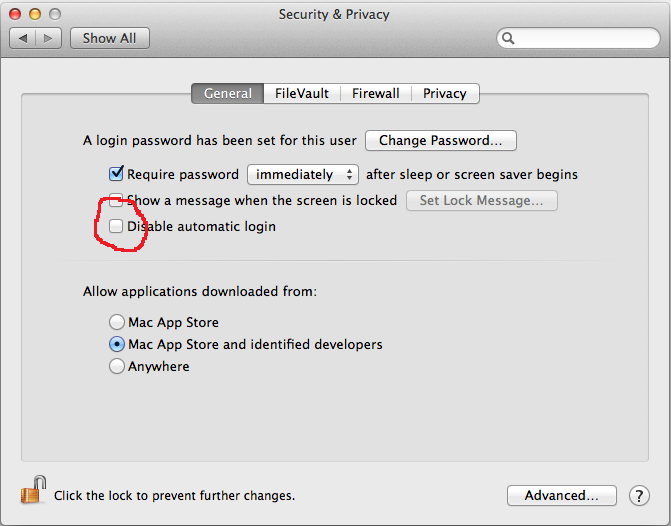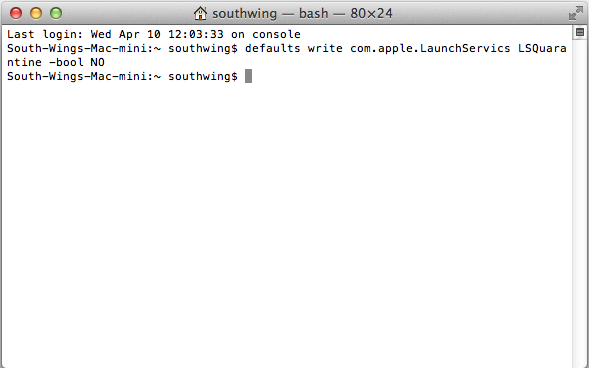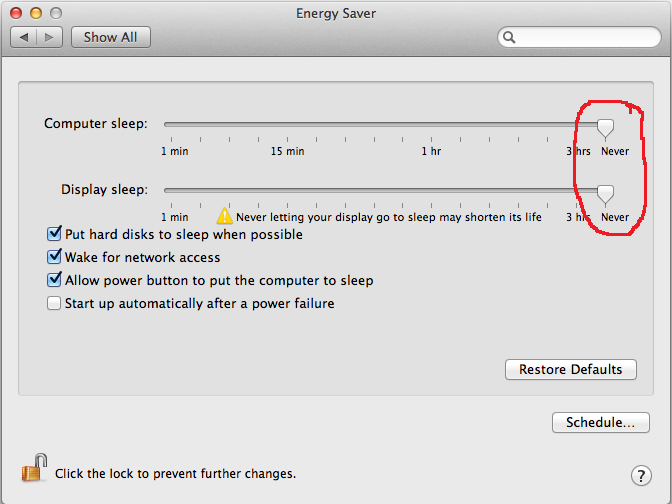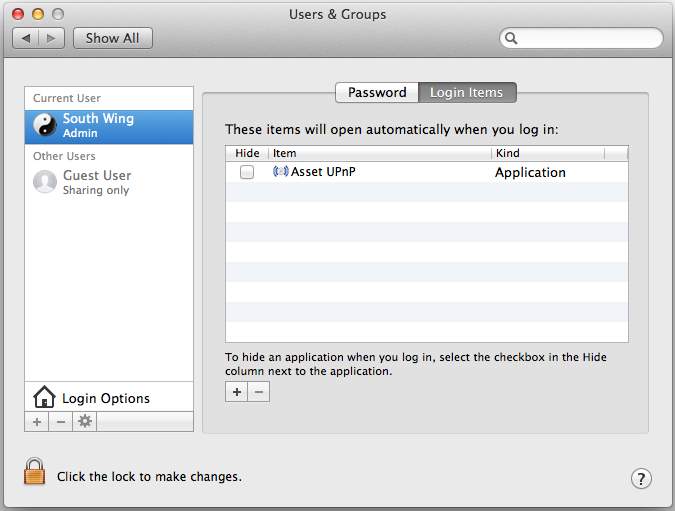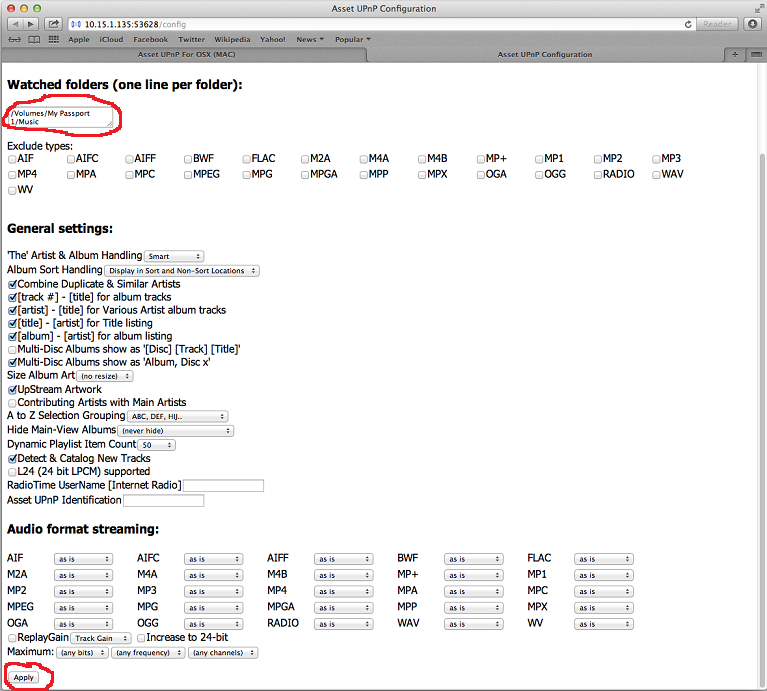Difference between revisions of "Mac mini NAS"
Rockfather (talk | contribs) (→Mac mini with USB drive as NAS) |
Rockfather (talk | contribs) |
||
| (7 intermediate revisions by the same user not shown) | |||
| Line 1: | Line 1: | ||
__NOTOC__ | __NOTOC__ | ||
__NOTOC__ | __NOTOC__ | ||
| − | |||
This describes how to setup a Mac mini with an external USB drive as a NAS. | This describes how to setup a Mac mini with an external USB drive as a NAS. | ||
| Line 19: | Line 18: | ||
** Ensure screen sharing is ON | ** Ensure screen sharing is ON | ||
** Make a note of the address to connect to | ** Make a note of the address to connect to | ||
| + | [[Image:MacScreenSharing.png]] | ||
| + | |||
| + | |||
** In the ''Computer Settings'' dialog | ** In the ''Computer Settings'' dialog | ||
*** Check both the boxes | *** Check both the boxes | ||
*** Enter password to use for connection | *** Enter password to use for connection | ||
| − | + | [[Image:MacVncOptions.png]] | |
| − | + | ||
* Enable auto-login | * Enable auto-login | ||
** Preferences -> Personal -> Security & Privacy-> General | ** Preferences -> Personal -> Security & Privacy-> General | ||
** Ensure Disable automatic login is un-checked | ** Ensure Disable automatic login is un-checked | ||
| − | + | [[Image:MacAutoLogin.png]] | |
| + | |||
* Disable ''downloaded from internet'' warning | * Disable ''downloaded from internet'' warning | ||
| Line 34: | Line 37: | ||
** Finder -> Applications -> Utilities -> Terminal | ** Finder -> Applications -> Utilities -> Terminal | ||
** Enter the command '''defaults write com.apple.LaunchServices LSQuarantine -bool NO''' and press enter | ** Enter the command '''defaults write com.apple.LaunchServices LSQuarantine -bool NO''' and press enter | ||
| − | + | [[Image:MacLSQuarantine.png]] | |
| + | |||
* Disable sleep mode(s) | * Disable sleep mode(s) | ||
** Preferences ->Hardware -> Energy Saver | ** Preferences ->Hardware -> Energy Saver | ||
** Set both ''Computer Sleep'' and ''Display Sleep'' to ''Never'' | ** Set both ''Computer Sleep'' and ''Display Sleep'' to ''Never'' | ||
| − | + | [[Image:MacEnergySaver.png]] | |
| + | |||
* Restart Mac and ensure it starts up and logs in without user intervention | * Restart Mac and ensure it starts up and logs in without user intervention | ||
| Line 63: | Line 68: | ||
** Disconnect monitor, keyboard and mouse from Mac | ** Disconnect monitor, keyboard and mouse from Mac | ||
** Connect the monitor dongle (described above) to Mac | ** Connect the monitor dongle (described above) to Mac | ||
| − | |||
* Check operation | * Check operation | ||
| Line 87: | Line 91: | ||
** Preferences -> Users & Groups -> Current User -> Login Items | ** Preferences -> Users & Groups -> Current User -> Login Items | ||
** Click ''+'' and select Applications -> Asset | ** Click ''+'' and select Applications -> Asset | ||
| − | + | [[Image:MacLoginItems.png]] | |
| + | |||
* Set watched folders | * Set watched folders | ||
| Line 94: | Line 99: | ||
** Add the ''Music'' folder on the USB drive | ** Add the ''Music'' folder on the USB drive | ||
** Press the ''Apply'' button | ** Press the ''Apply'' button | ||
| − | + | [[Image:MacAssetConfig.png]] | |
| Line 106: | Line 111: | ||
** Wait for it to fully start up | ** Wait for it to fully start up | ||
** Using Kinsky check that Asset is visible, and audio content shows in library | ** Using Kinsky check that Asset is visible, and audio content shows in library | ||
| + | |||
| + | |||
| + | === Add Disk 'No-Sleep' Functionality === | ||
| + | To prevent the USB hard drive from spinning down, which can lead to audio dropout, a utility is run once per minute to write (and flush) to the drive | ||
| + | |||
| + | * Install the '''tick.py''' script (tick.py) in the root of the USB Drive | ||
| + | #!/usr/bin/python | ||
| + | |||
| + | import time | ||
| + | |||
| + | f = open( '/Volumes/USBDrive1/timestamp.txt', 'at+' ) | ||
| + | f.write( time.asctime( time.localtime() ) + '\n' ) | ||
| + | f.close() | ||
| + | |||
| + | * Create the plist file '''~/Library/LaunchAgents/com.user.clock.plist''' | ||
| + | <?xml version="1.0" encoding="UTF-8"?> | ||
| + | <!DOCTYPE plist PUBLIC "-//Apple//DTD PLIST 1.0//EN" "http://www.apple.com/DTDs/PropertyList-1.0.dtd"> | ||
| + | <plist version="1.0"> | ||
| + | <dict> | ||
| + | <key>Label</key> | ||
| + | <string>com.user.clock</string> | ||
| + | <key>Program</key> | ||
| + | <string>/Volumes/USBDrive1/tick.py</string> | ||
| + | <key>StartInterval</key> | ||
| + | <integer>60</integer> | ||
| + | </dict> | ||
| + | </plist> | ||
| + | * Add this file to the launchctl executor | ||
| + | launchctl load ~/Library/LaunchAgents/com.user.clock.plist | ||
Latest revision as of 13:09, 24 September 2013
This describes how to setup a Mac mini with an external USB drive as a NAS.
Hardware
- Mac mini with Mountain Lion
- Monitor dongle as described here
- WD My Passport 2TB USB drive
- PC/Mac/iPad running a VNC viewer to remotely control the NAS
For initial setup ONLY, a monitor, keyboard and mouse will need to be connected to the Mac
Setup headless server
- Enable screen sharing
- Preferences -> Internet & Wireless -> Sharing
- Enable Screen Sharing service
- Ensure screen sharing is ON
- Make a note of the address to connect to
- In the Computer Settings dialog
- Check both the boxes
- Enter password to use for connection
- In the Computer Settings dialog
- Enable auto-login
- Preferences -> Personal -> Security & Privacy-> General
- Ensure Disable automatic login is un-checked
- Disable downloaded from internet warning
- Start terminal
- Finder -> Applications -> Utilities -> Terminal
- Enter the command defaults write com.apple.LaunchServices LSQuarantine -bool NO and press enter
- Disable sleep mode(s)
- Preferences ->Hardware -> Energy Saver
- Set both Computer Sleep and Display Sleep to Never
- Restart Mac and ensure it starts up and logs in without user intervention
- Apple -> Restart
Configure Remote Access
- Install a VNC viewer on the PC/Mac to be used for remote access
- On Windows suggest RealVNC
- On Mac suggest Chicken VNC
- On iPad there is VNC Viewer for £6.99, but this is untested
- Open the VNC client and check connection to the Mac
- Check the Mac is viewable and controllable from the VNC viewer
Check Operation
- Close VNC viewer (F8 to exit full-screen mode)
- Shutdown the Mac
- Make headless
- Disconnect monitor, keyboard and mouse from Mac
- Connect the monitor dongle (described above) to Mac
- Check operation
- Power up Mac
- Wait until powered up (after jingle)
- Connect remotely using VNC viewer as described above
If this can now control Mac then headless operation is correctly setup
Setup Media Server
- Install USB drive
- Plug in USB drive and wait for it to be detected
- Format drive for Mac OSX as described here
- Create a folder called Music on this drive, to store the audio files
- Install Media Server
- Download Asset UPnP for Mac
- Open dmg file and drag Asset to Applications
- Add to automatic startup
- Preferences -> Users & Groups -> Current User -> Login Items
- Click + and select Applications -> Asset
- Set watched folders
- Start Asset UPnP
- Select Configure
- Add the Music folder on the USB drive
- Press the Apply button
Final Checks
- Using Kinsky (from any machine on network)
- Check Asset is listed in the Libraries list
- Check audio content from USB drive is visible in library
- Restart
- Restart the Mac
- Wait for it to fully start up
- Using Kinsky check that Asset is visible, and audio content shows in library
Add Disk 'No-Sleep' Functionality
To prevent the USB hard drive from spinning down, which can lead to audio dropout, a utility is run once per minute to write (and flush) to the drive
- Install the tick.py script (tick.py) in the root of the USB Drive
#!/usr/bin/python import time f = open( '/Volumes/USBDrive1/timestamp.txt', 'at+' ) f.write( time.asctime( time.localtime() ) + '\n' ) f.close()
- Create the plist file ~/Library/LaunchAgents/com.user.clock.plist
<?xml version="1.0" encoding="UTF-8"?> <!DOCTYPE plist PUBLIC "-//Apple//DTD PLIST 1.0//EN" "http://www.apple.com/DTDs/PropertyList-1.0.dtd"> <plist version="1.0"> <dict> <key>Label</key> <string>com.user.clock</string> <key>Program</key> <string>/Volumes/USBDrive1/tick.py</string> <key>StartInterval</key> <integer>60</integer> </dict> </plist>
- Add this file to the launchctl executor
launchctl load ~/Library/LaunchAgents/com.user.clock.plist

